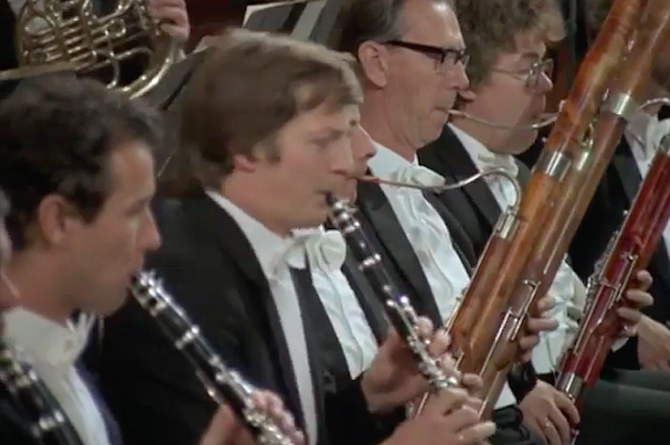 Facebook
Facebook
 X
X
 Instagram
Instagram
 TikTok
TikTok
 Youtube
Youtube

The last few days of unabated San Diego sunshine have me feeling particularly spring-ish even though we are technically in the dead of winter with spring still a month or so away. However, it did get me thinking. I don’t believe we’ve ever looked at spring-based music here in the column.
With that in mind, let’s look beyond the obvious spring-fare such as Vivaldi’s The Four Seasons: “La Primavera” and Stravinsky’s decidedly brutal depiction of rivers exploding out of their icy slumber in The Rite of Spring. Stravinsky includes human sacrifice as a tradition of spring. Ah, the good ol’ days when no virgin was safe from ritualistic murder.
There are, indeed, several pieces of classical music that bear the word “spring” in their title. One such piece is Edvard Grieg’s “To Spring” from his Lyric Pieces which are composed for piano. Lyric Pieces is a collection of 66 short compositions that Grieg composed between 1867 and 1901. Besides “To Spring” there are two pieces entitled “Spring Dance”. Both are just over one minute long.
Leonard Bernstein-Orq. Filarm. de Viena
Another composition with “spring” in the title is Spring by Alexander Glazunov. Glazunov is best known for his ballet entitled Seasons. There is a spring section in the ballet but this stand-alone piece from 1891 is so fresh and beautiful that it deserves to be listened to not a few times over the course of the next few weeks.
Claude Debussy took a human approach to spring in his symphonic suite entitled Spring. According to the archives of the Los Angeles Philharmonic, Debussy wrote the piece while in Rome. In a letter, he said that he didn’t want to write a description of spring the season but a human spring or rebirth.
Robert Schumann’s Symphony No. 1: Spring is so-called because of a letter he wrote to conductor Wilhelm Taubert. In the letter, Schumann asks, “Could you breathe a little of the longing for spring into your orchestra as they play? That was what was most in my mind when I wrote [the symphony] in January 1841.”
Johann Strauss II composed Voices of Spring as an indication of the spring breeze that flows through Vienna off of the Danube. Trust me, you’ve heard this one before.
The last piece of spring music comes from the Act IV duet “Oh Mimi tu piu non Torni” in Puccini’s La Boheme. At the conclusion of Act III, Rodolfo and Mimi pledge to stay together until spring because no one is ever lonely in spring. Well, it’s spring, and Rodolfo is feeling so very, very lonely. He commiserates with Marcello, who is missing Musetta, his so-called "hellcat".
I’m on the record as a Pavarotti “hater” but no one sings this music better than Pav.


The last few days of unabated San Diego sunshine have me feeling particularly spring-ish even though we are technically in the dead of winter with spring still a month or so away. However, it did get me thinking. I don’t believe we’ve ever looked at spring-based music here in the column.
With that in mind, let’s look beyond the obvious spring-fare such as Vivaldi’s The Four Seasons: “La Primavera” and Stravinsky’s decidedly brutal depiction of rivers exploding out of their icy slumber in The Rite of Spring. Stravinsky includes human sacrifice as a tradition of spring. Ah, the good ol’ days when no virgin was safe from ritualistic murder.
There are, indeed, several pieces of classical music that bear the word “spring” in their title. One such piece is Edvard Grieg’s “To Spring” from his Lyric Pieces which are composed for piano. Lyric Pieces is a collection of 66 short compositions that Grieg composed between 1867 and 1901. Besides “To Spring” there are two pieces entitled “Spring Dance”. Both are just over one minute long.
Leonard Bernstein-Orq. Filarm. de Viena
Another composition with “spring” in the title is Spring by Alexander Glazunov. Glazunov is best known for his ballet entitled Seasons. There is a spring section in the ballet but this stand-alone piece from 1891 is so fresh and beautiful that it deserves to be listened to not a few times over the course of the next few weeks.
Claude Debussy took a human approach to spring in his symphonic suite entitled Spring. According to the archives of the Los Angeles Philharmonic, Debussy wrote the piece while in Rome. In a letter, he said that he didn’t want to write a description of spring the season but a human spring or rebirth.
Robert Schumann’s Symphony No. 1: Spring is so-called because of a letter he wrote to conductor Wilhelm Taubert. In the letter, Schumann asks, “Could you breathe a little of the longing for spring into your orchestra as they play? That was what was most in my mind when I wrote [the symphony] in January 1841.”
Johann Strauss II composed Voices of Spring as an indication of the spring breeze that flows through Vienna off of the Danube. Trust me, you’ve heard this one before.
The last piece of spring music comes from the Act IV duet “Oh Mimi tu piu non Torni” in Puccini’s La Boheme. At the conclusion of Act III, Rodolfo and Mimi pledge to stay together until spring because no one is ever lonely in spring. Well, it’s spring, and Rodolfo is feeling so very, very lonely. He commiserates with Marcello, who is missing Musetta, his so-called "hellcat".
I’m on the record as a Pavarotti “hater” but no one sings this music better than Pav.
Comments